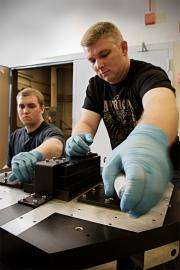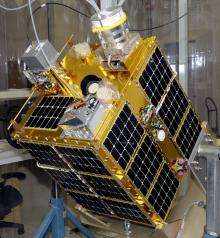Behind-the-Scenes Tests with the Webb Telescope's Mass Simulator

There are a lot of things that happen "behind the scenes" when a space telescope is being built and all of the components are being tested. In this recent photo, two technicians from NASA's Goddard Space Flight Center in Greenbelt, Md. were working with a "Mass Simulator" for the James Webb Space Telescope.
A mass simulator is used to replicate the weight and shape of an instrument and is attached to a main component of a space telescope or satellite to test the satellite's durability and sturdiness. The mass simulator is like a "dead weight" that contains no electronics or optics that the engineering test units contain. For each instrument that will fly on the James Webb Space Telescope, there are both mass simulators and engineering test units created.
Engineering Test Units are working models of the instruments that are used for testing and validation in laboratory tests, to ensure that they work properly.
In this photo, NASA Goddard Integration Technicians Brandon Gauss and Tony Keim are preparing the Webb telescope's Near-Infrared Spectrograph (NIRSpec) instrument mass simulator for integration onto the Webb's Integrated Science Instrument Module (ISIM) structure. The ISIM structure is the part of the telescope on which all of the mission’s science instruments will be mounted, so it is important that it maintain its rigidity otherwise it may affect the instruments that are attached to it) -- it maintain its rigidity to keep the instruments precisely in their places.

The engineers use these to test the strength of the ISIM by adding the simulated weight of instruments that will be mounted on it. These mass simulators are bolted to the ISIM before its next thermal test to verify the structure can safely handle the weight of the flight instruments during ISIM instrument alignment and performance verification testing. Any distortion of the ISIM would move the instruments out of focus.
The James Webb Space Telescope is the next-generation premier space observatory, exploring deep space phenomena from distant galaxies to nearby planets and stars. The Webb Telescope will give scientists clues about the formation of the universe and the evolution of our own solar system, from the first light after the Big Bang to the formation of star systems capable of supporting life on planets like Earth.
Provided by JPL/NASA





















